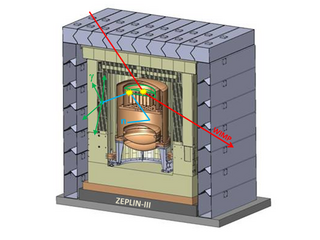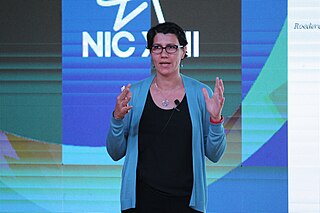Related Research Articles
ATHENA, also known as the AD-1 experiment, was an antimatter research project at the Antiproton Decelerator at CERN, Geneva. In August 2002, it was the first experiment to produce 50,000 low-energy antihydrogen atoms, as reported in Nature. In 2005, ATHENA was disbanded and many of the former members of the research team worked on the subsequent ALPHA experiment and AEgIS experiment.

TRIUMF is Canada's national particle accelerator centre. It is considered Canada's premier physics laboratory, and consistently regarded as one of the world's leading subatomic physics research centres. Owned and operated by a consortium of universities, it is on the south campus of one of its founding members, the University of British Columbia in Vancouver, British Columbia, Canada. It houses the world's largest normal conducting cyclotron, a source of 520 MeV protons, which was named an IEEE Milestone in 2010. Its accelerator-focused activities involve particle physics, nuclear physics, nuclear medicine, materials science, and detector and accelerator development.

Neutron detection is the effective detection of neutrons entering a well-positioned detector. There are two key aspects to effective neutron detection: hardware and software. Detection hardware refers to the kind of neutron detector used and to the electronics used in the detection setup. Further, the hardware setup also defines key experimental parameters, such as source-detector distance, solid angle and detector shielding. Detection software consists of analysis tools that perform tasks such as graphical analysis to measure the number and energies of neutrons striking the detector.

The Daya Bay Reactor Neutrino Experiment is a China-based multinational particle physics project studying neutrinos, in particular neutrino oscillations. The multinational collaboration includes researchers from China, Chile, the United States, Taiwan, Russia, and the Czech Republic. The US side of the project is funded by the US Department of Energy's Office of High Energy Physics.
T2K is a particle physics experiment studying the oscillations of the accelerator neutrinos. The experiment is conducted in Japan by the international cooperation of about 500 physicists and engineers with over 60 research institutions from several countries from Europe, Asia and North America and it is a recognized CERN experiment (RE13). T2K collected data within its first phase of operation from 2010 till 2021. The second phase of data taking is expected to start in 2023 and last until commencement of the successor of T2K – the Hyper-Kamiokande experiment in 2027.
The High Luminosity Large Hadron Collider is an upgrade to the Large Hadron Collider, operated by the European Organization for Nuclear Research (CERN), located at the French-Swiss border near Geneva. From 2011 to 2020, the project was led by Lucio Rossi. In 2020, the lead role was taken up by Oliver Brüning.

The LHCf is a special-purpose Large Hadron Collider experiment for astroparticle physics, and one of nine detectors in the LHC accelerator at CERN. LHCf is designed to study the particles generated in the forward region of collisions, those almost directly in line with the colliding proton beams.

CDHS was a neutrino experiment at CERN taking data from 1976 until 1984. The experiment was officially referred to as WA1. CDHS was a collaboration of groups from CERN, Dortmund, Heidelberg, Saclay and later Warsaw. The collaboration was led by Jack Steinberger. The experiment was designed to study deep inelastic neutrino interactions in iron.

The European Underground Rare Event Calorimeter Array (EURECA) is a planned dark matter search experiment using cryogenic detectors and an absorber mass of up to 1 tonne. The project will be built in the Modane Underground Laboratory and will bring together researchers working on the CRESST and EDELWEISS experiments.

EDELWEISS is a dark matter search experiment located at the Modane Underground Laboratory in France. The experiment uses cryogenic detectors, measuring both the phonon and ionization signals produced by particle interactions in germanium crystals. This technique allows nuclear recoils events to be distinguished from electron recoil events.
The Baikal Deep Underwater Neutrino Telescope (BDUNT) is a neutrino detector conducting research below the surface of Lake Baikal (Russia) since 2003. The first detector was started in 1990 and completed in 1998. It was upgraded in 2005 and again starting in 2015 to build the Baikal Gigaton Volume Detector (Baikal-GVD.) BDUNT has studied neutrinos coming through the Earth with results on atmospheric muon flux. BDUNT picks up many atmospheric neutrinos created by cosmic rays interacting with the atmosphere – as opposed to cosmic neutrinos which give clues to cosmic events and are therefore of greater interest to physicists.

The NA62 experiment is a fixed-target particle physics experiment in the North Area of the SPS accelerator at CERN. The experiment was approved in February 2007. Data taking began in 2015, and the experiment is expected to become the first in the world to probe the decays of the charged kaon with probabilities down to 10−12. The experiment's spokesperson is Cristina Lazzeroni. The collaboration involves 333 individuals from 30 institutions and 13 countries around the world.

MoEDAL is a particle physics experiment at the Large Hadron Collider (LHC).
The DarkSide collaboration is an international affiliation of universities and labs seeking to directly detect dark matter in the form of weakly interacting massive particles (WIMPs). The collaboration is planning, building and operating a series of liquid argon time projection chambers (TPCs) that are employed at the Gran Sasso National Laboratory in Assergi, Italy. The detectors are filled with liquid argon from underground sources in order to exclude the radioactive isotope 39
Ar, which makes up one in every 1015 (quadrillion) atoms in atmospheric argon. The Darkside-10 (DS-10) prototype was tested in 2012, and the Darkside-50 (DS-50) experiment has been operating since 2013. Darkside-20k (DS-20k) with 20 tonnes of liquid argon is being planned as of 2019.

Gary D. Westfall is an American experimental nuclear and high energy physicist and University Distinguished Professor at Michigan State University. He is also a co-author, with Wolfgang Bauer, of the introductory calculus-based physics textbook University Physics, published by McGraw-Hill in 2010.

The ZEPLIN-III dark matter experiment attempted to detect galactic WIMPs using a 12 kg liquid xenon target. It operated from 2006 to 2011 at the Boulby Underground Laboratory in Loftus, North Yorkshire. This was the last in a series of xenon-based experiments in the ZEPLIN programme pursued originally by the UK Dark Matter Collaboration (UKDMC). The ZEPLIN-III project was led by Imperial College London and also included the Rutherford Appleton Laboratory and the University of Edinburgh in the UK, as well as LIP-Coimbra in Portugal and ITEP-Moscow in Russia. It ruled out cross-sections for elastic scattering of WIMPs off nucleons above 3.9 × 10−8 pb from the two science runs conducted at Boulby.
The Cadmium Zinc Telluride 0-Neutrino Double-Beta (COBRA) experiment is a large array of cadmium zinc telluride (CdZnTe) semiconductors searching for evidence of neutrinoless double beta decay and to measure its half-life. COBRA is located underground, within the Gran Sasso National Laboratory. The experiment was proposed in 2001, and installation of a large prototype began in 2006.
The Gas Dynamic Trap is a magnetic mirror machine being operated at the Budker Institute of Nuclear Physics in Akademgorodok, Russia.
Marielle Chartier is a Professor of Particle Physics at the University of Liverpool in England. Her research investigates the phase diagram of nuclear matter using the ALICE experiment at the Large Hadron Collider (LHC) at CERN Her past work includes nuclear structure at the frontiers of the valley of stability.

Artemisia (Artemis) Spyrou is an experimental nuclear astrophysicist and professor at Michigan State University. She is also the Associate Director for Education and Outreach at the National Superconducting Cyclotron Laboratory. She was the recipient of a NSF CAREER Award.
References
- ↑ Luther, B.; Baumann, T.; Thoennessen, M.; et al. (June 2003), "MoNA—The Modular Neutron Array", Nuclear Instruments and Methods in Physics Research Section A , 505 (1–2): 33–35, Bibcode:2003NIMPA.505...33L, doi:10.1016/s0168-9002(03)01014-3
- ↑ Baumann, T.; Boike, J.; Brown, J.; et al. (May 2005), "Construction of a modular large-area neutron detector for the NSCL", Nuclear Instruments and Methods in Physics Research Section A , 543 (2–3): 517–527, Bibcode:2005NIMPA.543..517B, doi:10.1016/j.nima.2004.12.020
- ↑ Zelevinsky, V.; Volya, A. (2006), "Continuum Shell Model, Reactions and Giant Resonances", in Woehr, A.; Aprahamian, A. (eds.), Capture Gamma-Ray Spectroscopy and Related Topics: 12th International Symposium, 4–9 September 2005, Notre Dame, Indiana, AIP Conference Proceedings, vol. 819, American Institute of Physics, pp. 493–497, doi:10.1063/1.2187905
- ↑ Prestemon, S.; Bird, M. D.; Crook, D. G.; et al. (March 2001), "Structural design and analysis of a compact sweeper magnet for nuclear physics", IEEE Transactions on Applied Superconductivity , 11 (1): 1721–1724, Bibcode:2001ITAS...11.1721P, doi:10.1109/77.920115
- ↑ Toth, J.; Bird, M. D.; Miller, J. R.; et al. (March 2002), "Final design of a compact sweeper magnet for nuclear physics", IEEE Transactions on Applied Superconductivity , 12 (1): 341–344, Bibcode:2002ITAS...12..341T, doi:10.1109/tasc.2002.1018415
- ↑ Bird, M. D.; Bole, S.; Gundlach, S.; et al. (June 2004), "Cryostat Design and Fabrication for the NHMFL/NSCL Sweeper Magnet", IEEE Transactions on Applied Superconductivity , 14 (2): 564–567, Bibcode:2004ITAS...14..564B, doi:10.1109/tasc.2004.829720, S2CID 34670655
- ↑ Bird, M. D.; Kenney, S. J.; Toth, J.; et al. (June 2005), "System Testing and Installation of the NHMFL/NSCL Sweeper Magnet", IEEE Transactions on Applied Superconductivity , 15 (2): 1252–1254, Bibcode:2005ITAS...15.1252B, doi:10.1109/tasc.2005.849553, S2CID 24997693
- ↑ Frank, N. (2006), Spectroscopy of Neutron Unbound States in Neutron Rich Oxygen Isotopes (Ph.D. Thesis), Michigan State University
- ↑ Bazin, D.; Caggiano, J. A.; Sherrill, B. M.; et al. (May 2003), "The S800 spectrograph", Nuclear Instruments and Methods in Physics Research Section B , 204: 629–633, Bibcode:2003NIMPB.204..629B, doi:10.1016/s0168-583x(02)02142-0
- ↑ Howes, R. H.; Baumann, T.; Thoennessen, M.; et al. (February 2005), "Fabrication of a modular neutron array: A collaborative approach to undergraduate research", American Journal of Physics , 73 (2): 122–126, Bibcode:2005AmJPh..73..122H, doi:10.1119/1.1794758